Abstract
In recent years, many researchers have focused on the preparation of carbon and basalt fiber-reinforced composites. As a result, the composites have gained popularity as an alternative to traditional materials such as wood, steel, and aluminum. Carbon and basalt fibers were used in a bidirectional woven mat, with particulates varying from 0 to 15 wt% nanoparticle SiC. The hybrid laminates were fabricated through vacuum bag infusion methods. The novelty of the research work lies in studying the influence of nanoparticle SiC-combined carbon and basalt fibers arranged in six stacking sequences, with LY556 used as polyester matrix. Specimens were prepared and tested as per ASTM standards. Tensile, flexural, impact, and hardness tests were performed on the obtained specimens and average values were obtained. It was found that 15% SiC filler addition enhanced (20%) the mechanical properties. Scanning electron microscope photos revealed the bonding between the fiber mat and the matrix of thecrystal structure. The obtained tensile strength was 346 MPa and the flexural strength was 388 MPa. Dynamic mechanical analysis showed that mechanical properties were improved with the addition of 15% SiCnanoparticles. Hence, this method can be used to manufacture structural applications and automotive parts.
1. Introduction
Polymer matrix composites (PMCs) are lighter in weight and have high stiffness and strength. Because of their better properties in comparison to conventional materials, fiber-reinforced polymer composites are gaining popularity in contemporary industrial applications. Future developments are centered on the development of hybrid composite materials that can replace wood, plastic, and other materials. In this study, a thorough review of the relevant literature was conducted to determine the appropriate content selections and identify research gaps. Dynamic mechanical analysis was conducted to study the mechanical properties of the PMCs.
DMA frequency scans were used to investigate the melt behavior of polymeric materials. DMA can determine Young’s modulus, elastic limits, yield strength, linearity, breaking time and temperature, toughness, and maximum dynamic stress by measuring strain. Fibers made of carbon and basalt crate were developed using a projection method and the correlation between fiber density and properties such as the elastic modulus and the bending strength were determined. It was found that the mechanical and thermal properties of the composite material improved with an increase in density [1].
Because of their lightweight and superior mechanical characteristics, carbon fiber-reinforced composites with polymer matrix were studied as a potential replacement material for traditional metals in aerospace and automotive applications. This article will discuss the steps involved in placing the specimen by hand. Properties such as tensile strength, hardness, and impact resistance were characterized using various ASTM standards. Basalt fibers, which exist in different shapes, were used to strengthen polyester resin, which served as the matrix material in this investigation [2].The relationship between various polymer matrices was studied, and it was found that the common presumption that filled modules irrespective of the matrix is wrong, thereby explaining the apparent underachievement of graphene in some situations. The factors that affect nanocomposites were also carefully investigated, and it was found that graphene addition increases the material characteristics even at low loads. Nanocomposite materials based on graphene have been recognized for their potential for innovation [3].
Carbon fiber (CF) composites could be replaced by metals for structural applications, but the material’s high price has slowed its adoption. Synthetic composites with the desired mechanical characteristics may be created by mixing CF with basalt fiber in a reasonable amount. The diffusion, tensile strength, flexural strength, and impact resistance of the hybrid composites were examined, along with the effect of carbon and basalt fiber stacking systems. After placing salt water and hand-laid composites at room temperature for 90 days, the materials were ready for use. Compared to untreated composites, treated composites showed better mechanical properties. The hybrid composites were found to have the greatest dry flexural strength (490 MPa) [4,5].
The hybrid composite’s diffusion coefficient in salt water was 44% lower than that of the CF reinforced by a simple epoxy matrix [6]. The tribological properties of epoxy composites containing 0, 0.2, 0.4, 0.6, and 0.8 wt% carbon nanofibers (CNFs) were investigated. The experimental results revealed that epoxy composites containing 0.4 wt% CNFs showed the minimum friction coefficient and reasonable wear resistance [7]. This work intended to present a critical analysis of the current status of basalt FRC materials based on the data available in the literature, with an emphasis on the increasing trend in basalt composite research and publications. In addition, this article also discusses the physicochemical and mechanical properties of basalt fibers.
The novelty of this article is reinforcement with filler addition to examine the mechanical properties, which are changed and updated in this article. Previous literature is referred to and cited in this article, but using different materials—the filler materials have been varied in this article (0–15%). Research gaps pertaining to different types of natural fibers made using the hybridization method were identified from the literature. The novelty of this research work was the study of the influence of SiC nanoparticle-reinforced fiber and basalt fibers alternatively arranged in six stacking sequences, with LY556 used as polyester matrix. The hybrid fiber-reinforced composites outperformed individual fibers in terms of strength and rigidity. Aramid Kevlar fiber had excellent thermal heat resistance and CF had better strength compared to other natural fibers. When all three fibers were evaluated and an alternate stacking sequence was used to manufacture the hybrid composite laminate, the tensile and thermal characteristics were improved. It was found that these mixed composite materials could be used for roofing and structural applications [8].
2. Reinforcements and Fabrications
2.1. Reinforcement Used
For this study, a bidirectional woven mat with 300 GSM woven carbon and basalt fiber was prepared. Materials were obtained from M/s. SM Composites in TamilNadu, whereas filler particles were obtained from Sigma-Aldrich Chemicals, Porur, Tamil Nadu, India. The physical characterization of CF was determined by the production process when polyester is used [9]. Figure 1 shows carbon, basalt, and nanofibers used as reinforcements for composite fabrication.

Figure 1.
Reinforcements and equipment used for fabricating composites (a) fibers, (b) matrix, (c) tools and equipment.
Figure 1 shows the equipment and tools used for fabricating composite. Synthetic fibers with good mechanical properties are widely and easily available. The fiber mat allows the polyester resin to flow between layers and increase the bonding capacity. To make glass, carbon and Kevlar fiber mats, measuring 300 mm in length and 300 mm in width, and 210 g fiber were used. General polyester was used as a catalyst and accelerator [10,11,12]. The matrix ratio of 10:1:1 resin and hardener provided the dual purpose of acting as a binder and curing the hybrid composite. Various properties of carbon and basalt fiber and polyester matrix are shown in Table 1 [13]. Polyester is used as matrix martial because it has low viscosity, low density, low cost, and mechanical properties similar to an epoxy matrix. Basalt fiber has greater impact strength, carbon fiber has greater strength compared to glass fiber, and polyester has better mechanical properties, so new developed hybrid composites will have better mechanical properties for structural applications and automobile parts.

Table 1.
The physical characteristics of reinforcements.
The size of the SiC is 10 μm. The advantages of filler addition to the hybrid composite include low density, high strength, good thermal, higher hardness, and lower wear properties. These properties have increased their demand for structural applications in the fields of aerospace, civil engineering, military, motorsports, and other sports equipment manufacturing.
2.2. Preparation of Composite Laminates
Reinforced polymer laminates (250 mm × 250 mm × 6 mm) were constructed using SiC nanoparticles as filler and a fiber-reinforced mat (basalt fiber), which was prepared with six layers of bidirectional carbon. Different stacking sequences used in manufacturing are shown in Figure 2.
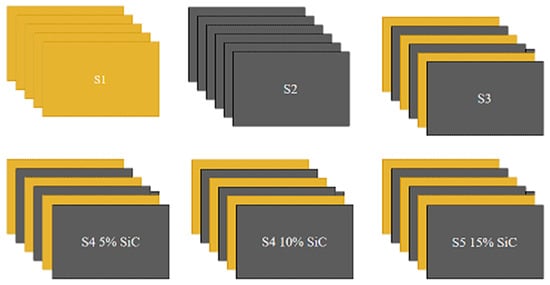
Figure 2.
Different stacking sequences used for fabrications.
2.3. The Vacuum Bag Infusion Method
Figure 2 and Table 2 show the arrangement of six types of composite laminates. In the S1 sample, all six layers used only basalt; the S2 sample was fabricated with only carbon fiber; the S3 sample was fabricated with alternative layers of basalt and carbon fiber; and samples 4–6 were developed using alternative carbon and basalt layers with filler materials. Figure 2 shows the arrangement of six types of composite laminates. In the S1 sample, all six layers used only basalt; the S2 sample was fabricated with only carbon fiber; the S3 sample was fabricated with alternative layers of basalt and carbon fiber; and samples 4–6 were developed using alternative carbon and basalt layers with filler materials. Vacuum infusion mold setups were prepared. The bottom surface was preparing with release agent wax. Neat fibers without filler and with filler SiC nanoparticles of six stacking sequences were used. Six laminates were fabricated by changing the weight percentage of the fiber volume fraction. C/B/C/B/C/B with polyester was used a bonding agent. Filler-added SiC nanoparticles at5–15 wt% were prepared. Various laminates fabricated are shown in Figure 3. Finally, they were covered with a plastic sheet using a sealant tape. One end of the corner was attached to a vacuum pump to suck the additional resin from the mold [14,15,16]. Two bar pressure was maintained for 8–10 min. After removal of excess resin, the composite laminate was opened, and a hot-air oven was used to dry them. After curing for 24 h, a 25 kg weight needed to be maintained. Figure 4 shows the fabrication of composite materials and different hybrid composite laminates [17].

Table 2.
Composition specimen layering.
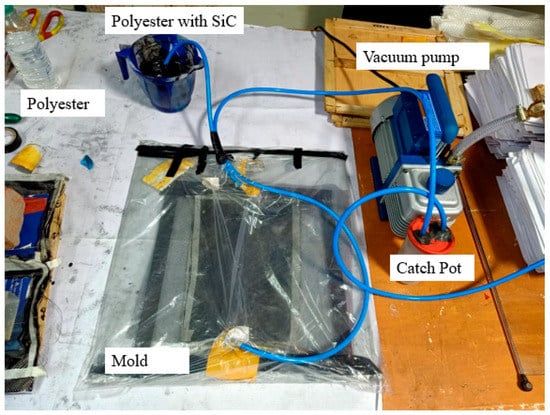
Figure 3.
Preparation of composite materials using the vacuum bag infusion technique.
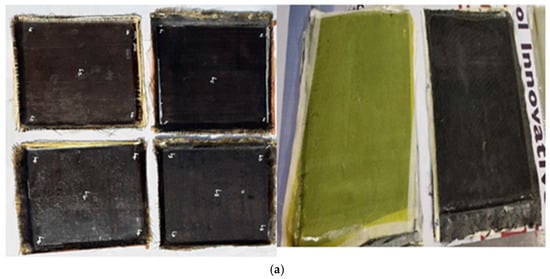
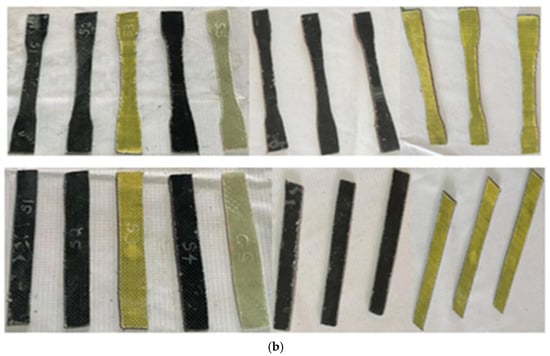
Figure 4.
Fabricated and prepared composite samples with varying stacking sequences (a) fabricated Laminates; (b) cut test sample.
Figure 4 shows composite shield speared using varied stacking sequences. Tensile, flexural, impact, and DMA specimens were prepared in accordance with ASTM standards. The specimen’s size was 65 mm × 12.7 mm × 3 mm. The DMA experiments were carried out at temperatures ranging from −30 to 200 °C following ASTM Standard D4065-12. A dynamic automated temperature analyzer was used to calculate the storage modulus (E1), the loss modulus (E2), and the mechanical loss factor (tan delta) as a function of temperature (T). The specimens used to perform the DMA test are shown in the figure [18,19].
2.4. Inference on the Vacuum Bag Infusion Method
The vacuum bag infusion outperforms the hand layup approach in various ways. The advantages include a higher fiber-to-resin ratio, a lower resin demand, use of consistent resin, and an infinite setup time. Vacuum bagging can minimize drying time and voids while enhancing composite material characteristics.
The vacuum bag removes the excess amount of resin, but this depends on a number of variables including reinforcement, resin, and processing time. Figure 5 shows the SEM image of the composite produced using the vacuum bagging method. A sufficient quantity of resin was prepared by adding polyester resin and hardener at an appropriate ratio. The composite was made by applying the polyester resin slowly [20,21,22,23,24]. It was ensured that the air does not become trapped to create blowholes. An even unidirectional vacuum pressure was applied while using the vacuum pump and the vacuum bagging process. This ensured that the binders were properly distributed during the reinforcement. Thus, the composite produced had minimum defects. During manufacturing of the composite, no anomalies occurred due to error although nano-cracks were observed at specific places in the composite. Then, no-cracks occurred because of stress during the thermally induced expansion (exothermic reaction) of the binder during the setting of the adhesive.
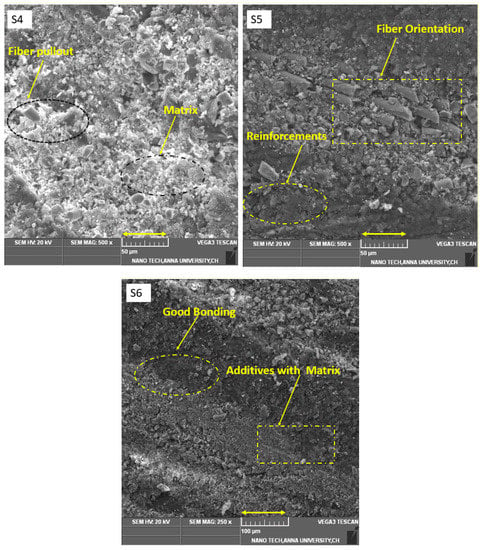
Figure 5.
SEM image of the S4, S5, and S6 hybrid composites before testing.
2.5. Experimental Setup
The purpose of the test was to ascertain not only the quality of the material but also the manner in which it failed when subjected to the load applied. UTM was the equipment used in this investigation to assess the mechanical characteristics of the materials. The grip was changed to a three-point bend configuration so that all of the tests—tensile, impact, flexural, and hardness—could be carried out on the same machine. The impact resistance and hardness of the composite laminates manufactured were evaluated with the assistance of an Izod impact testing machine and a Shore D hardness testing apparatus, respectively. The results of each mechanical characterization experiment were based on the evaluation of three samples, and the mechanical properties were determined by taking the average of three evaluations. To facilitate comparisons of the mechanical properties of the hybrid laminate combinations, the combinations were termed S3, S4, S5, and S6, while the two remaining versions of the neat composite laminates were coded S1 and S2, respectively, in hybrid polymer matrix composite (HPMC) [25,26,27,28].
3. HPMC Results and Discussion
3.1. The Tensile Strength of the Composite Samples Produced
To investigate the impact that vacuum bag infusion exerted on the strength properties of the composites, mats containing carbon/basalt fibers as reinforcing materials were subjected to a variety of stacking sequences during tensile testing. The changes in the tensile strength of the manufactured composite laminates with different sequencing configurations are shown in Figure 6. Fibers that do not modify in any way, as well as alternative fibers with a varying wt% of nanoparticles, can be used in the preparation of polyester matrix composites. Each sequencing combination had a greater tensile strength compared to polyester bonding agents as a comparison material [29,30,31]. When compared to other arrangements, the composite prepared using the CBCBCB sequencing with 15 wt% SiC showed the maximum tensile force of 346 MPa.
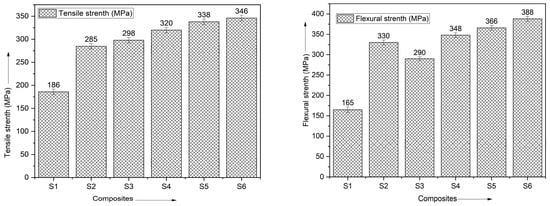
Figure 6.
Tensile and flexural strength of hybrid laminates.
The tensile modulus of the CBCBCB sequencing composite laminate increased by 10% (from 320 to 334 MPa) due to incorporation of nanoparticles as an outer reinforcing material. This was in comparison to the fracture toughness of the CBCBCB sequence. It was observed that incorporating carbon fillers into composites results in an improvement in their tensile properties. A comparison of the tensile strengths of several composite materials is shown in Figure 6. Regarding the mechanical properties, the laminate with 15% filler between layers showed the strongest tensile strength of 346 MPa. S2 has a maximum strength of 280 MPa when compared to pure laminates. In contrast, the CBCBCB composite laminates, S3, S4, and S5, showed enhanced mechanical qualities due to an intermediate bonding film connecting fiber and particulate filler material. There was a 20% increase in the strength [32,33,34,35]. After discovering that the composite had the stacking sequence CBCBCB, it was decided that the experimental findings be discussed using subheadings with a clear and concise summary of the findings, their interpretations, and the inferred implications.
3.1.1. Visual Representation of Fractographical Tensile Fracture Specimens
Figure 7 is a scanning electron microscope image of the surface topography of a deformation composite specimen. Matrix cracking, fiber breaking, fiber pullout, and peeling between both the matrix and the fiber are seen [36,37,38].
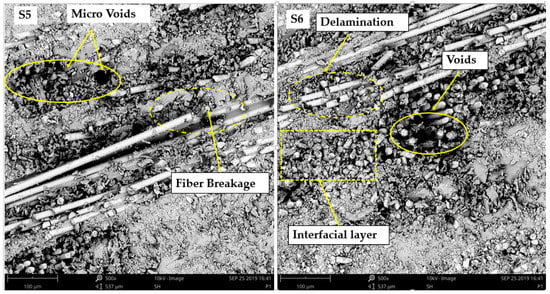
Figure 7.
SEM image of S5 and S6 laminate after fracture.
3.1.2. Breakage of the Fiber Due to an Increase in the Transverse Stress
Samples 1 and 5 share the identical loading matrix, minus any unnecessary padding components. Weight distribution and sharing for specimens with 60% fiber composites were significantly inadequate in this study. Matrix fracture due to transverse load was addressed by agglomeration, which was conceptually similar to the uneven additional filler distribution in the laminate sample. Nano voids, broken fibers, and particles in a separate region besides the composites were discovered by the scans. Weaknesses occurred in both tensile and flexural rigidity, but when placed in a polyester resin, the hybrid fibers improved the mechanical qualities because the tissues no longer absorbed water. The SEM image further showed that the presence of microparticles was the principal reason for cracking under stress [39].
3.2. Flexural Characteristics of the Composites
The bending strength of carbon with basalt strands as reinforcement fibers in mat form was evaluated with the inclusion of SiC in a variety of stacking sequences. The purpose of this was to evaluate the impact that a chemical treatment exerts on the flexural strength of a material. The differences between clean laminates and hybrid composites containing filler components are illustrated in Figure 7. Even without the addition of filler in the composite material, the prepared hybrid composites showed sufficient flexural strength. This was due to the isotropic character of the woven fibers.
The flexural strength of composites containing plain basalt fiber was significantly lower than that of their equivalents. The composite that did not include any filler had the weakest flexural strength, measuring 165 MPa. This was compared with the composite that had extra SiC filler in each and every fiber, which measured 388 MPa. Because the fibers could not assist in the absorption and transmission of the applied load, the weight was borne almost entirely by the resin and the fibers themselves. The bonding strength was used to perform a strength comparison of several different composites. Using particles as the filler, the reinforcement material showed a 5% increase in strength properties when there were three intermediate layers of carbon. Similarly, it was found that increasing the percentage of carbon fillers contributed to an increased flexural strength. The results of the experiments revealed that the flexural properties of the composites were improved due to the use of the SiC filler. However, basalt fiber exhausted its capacity to sustain the applied load. This led to an insignificant decrease in the flexural strength. In this study, the composite material with SiC filler and substrate between fibers demonstrated the greatest elasticity modulus of 380 MPa. The polyester substrate of single synthetic fibers contributed to an improvement in the material’s flexural strength. The tensile and flexural strengths were at their greatest in the CBCBCB sequence, which indicated that the material’s carbon content contributed to its increased strength. The technical explanation is that the outer layer of carbon fiber has greater stiffness and strength due to the strong interfacial connection of matrix and reinforcement. This approach fulfills the requirements for surface strength and durability. The bending stress and the elastic modulus increased as the silicon carbide concentration increased [40,41,42].
3.3. Fractographical Image of Flexural Fracture Specimens
Figure 8 illustrates the compression that occurs after a fracture takes place in a composite material with the layering sequencing CBCBCB. It also demonstrates the compression that occurs in its counterparts prepared using fibers. It is clear from the pictures that the collages and the threads together created holes in another area. The flexural load-bearing capability of the hybrid composite was negatively impacted as a result of this.
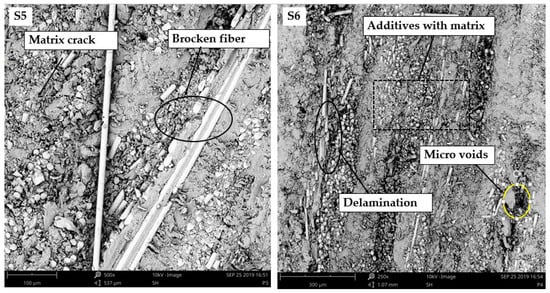
Figure 8.
SEM images of the S5 and S6 hybrid composites after flexural test.
Hybrid composites have a much greater flexural strength than single-reinforcement composites. The bending strength of composites made with all three reinforcing materials in a variety of stacking sequences with fillers showed an increase of 5–10% compared to fiber-reinforced composites. The flexural strength of composites made with the fiber stacking sequence CBCBCB was 388 MPa, the greatest of any stacking sequence tested. They failed the water absorption test with only a few minor issues. In the stacking sequences, a thin stranded carbon fiber was typically used as filler between the carbon strengthening components. This mixture, together with the longitudinal orientation of the agglomerate, resulted to equal distribution of the applied stress throughout the layers, increasing its ability to withstand external weight [43,44,45,46].
3.4. Impact Composites Characteristics
To perform and track the energy storage capabilities of a material, an Izod impact test was conducted. Forces of impact are seen to vary widely in Figure 9. The impact strength of hybrid composites S3–S6 is low compared to that of S1. To increase the impact strength, it is thought that the addition of successive layers of identical reinforcing fibers can increase stiffness [47]. All six layers of basalt threads and alternately stacked basalt fibers in ordinary laminated S2 and hybrid composite S1 boost the impact strength. Composite material S6, with sequentially layered basalt fibers placed between carbon fibers, absorbed the maximum energy (15 J) in any of the tested materials. Similarly, S3 structures included alternately stacked basalt strands and sandwiched basalt fibers [48,49,50].
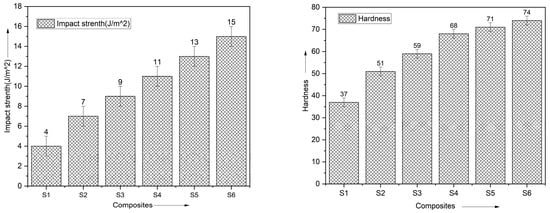
Figure 9.
Impact and hardness of the hybrid laminates.
As for impact absorption, the carbon fiber was on par with pure basalt fiber at 3 J. The composite material laminates provide maximum impact energy compared to ordinary basalt and carbon fiber [30,31,32]. The polyester matrix can withstand up to 13 J of force because of a modified stacking sequence (CBCBCB).
3.5. Hardness Characteristics of Composites
The hardness of the six hybridized and two simple composite laminates made from basalt or carbon fibers in this investigation is shown in Figure 9. Of the 37 specimens tested, the one reinforced with different layers of fiber reinforcement (S1) had the softest surface (lowest shore-D hardness). Similar materials with different layers of carbon fiber (S2) have a hardness of 50 [33,34,35,36]. We obtained a maximum of 74 by changing the stacking of the hybrid composite.
It would appear that basalt fiber can take on more abrasion than regular basalt fiber. However, hybrid composites based on the S5 and S6 systems can theoretically achieve S6 levels of hardness. This demonstrates how hybridization affects the strength of the resulting composite laminates.
3.6. Dynamic Mechanical Analysis
Figure 10 displays the dynamic mechanical study of a PMC [37,38,39]. This figure demonstrates how the storage modulus, E, of the analyzed composites varies due to temperature. The decrease in the storage modulus among all composites may be related to an increase in the deformability of the polymerization. This phenomenon is observed when the temperature is increased from its initial state.
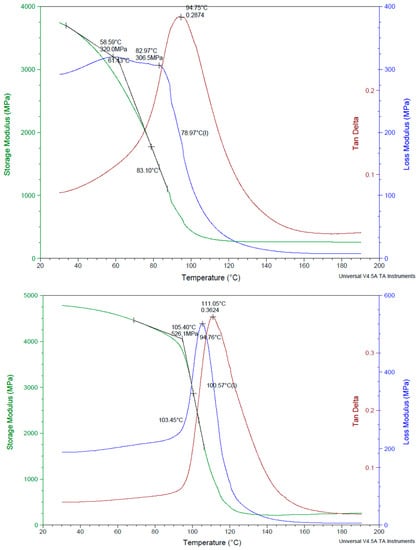
Figure 10.
DMA properties of S3 with 15 wt% and without SiC composite laminates.
The results of a dynamic mechanical analysis of a polyester matrix composite are depicted in Figure 10 [27,28,29,30]. They demonstrate how the composites experience a variation in their storage modulus, denoted by the letter E, as a function of temperature. When the temperature increases, the molecular mobility of the polymer chains increases, which causes the storage modulus of all composites to drop. Tan delta, also known as loss angle or dissipation factor, is a cable diagnostic tool used to measure the integrity of cable insulation [46,47,48]. This is used to determine the remaining life expectancy of a cable system under test and to prioritize scheduled maintenance, replacement, or rejuvenation. The storage modulus of an elastic solid measures its resistance to deformation. Hooke’s law, which asserts that extension increases with force, is connected to the proportionality constant between stress and strain. The storage modulus is 3000 MPa for S6 hybrid composite materials [48,49,50].
It is based on other research recommendations and different additives. We followed the same trends. When more additives were added, agglomeration occurred, thus the microstructure study that additives were uniformly distributed. The research work results showed that the composite with 15% filler content shows good mechanical properties [51,52,53].
The future scope of the study will use X-ray crystallography, the experimental science determining the atomic and molecular structure of a crystal, in which the crystalline structure causes a beam of incident X-rays to diffract into many specific directions. Fourier-transform infrared spectroscopy (FTIR) as a technique used to obtain the infrared spectrum of the absorption or emission of a solid, liquid, or gas may also be studied.
4. Conclusions
The following inferences were made using the results of the tension, bending, shock, toughness, dynamic mechanical, crystal structure, and morphological tests: the S6 specimen had the best properties. A polyester matrix consisting of 15 wt% SiC nanoparticles had a far greater tensile strength (346 MPa) than samples 1 and 2 and hybrid compositions. As a result of the reinforcement of the polyester matrix with filler SiC particles at 15 wt%, the flexural strength of the resulting composition was enhanced to 388 MPa, much above the initial failure strength of laminates. The filler content in the polyester matrix determines the tensile and flexural properties of the material. At an impact strength of 15 J/s, the performance of the polyester matrix without filler materials decreased by 20% when reinforced with SiC nanoparticles compared to neat and hybrid specimens (0, 5, 10, and 15 wt%).
Adynamic mechanical analysis was used to compare the storage modulus and the loss modulus of the polyester resin. Following the manufacture of fiber-reinforced composites, the fractography of laminates was conducted. Several fiber mats and polyester matrix interfaces were analyzed using SEM for evaluating the flexural and tensile strengths of the specimens. Particles containing additives exhibited a number of defects, including fiber pullout, matrix deboning, voids, fiber breakages, and delamination; nevertheless, the inclusion of SiC improved the bonding interaction between the fiber and matrix by as much as 50%. These tests and studies prove that carbon/basalt polyester composites reinforced with 15 wt% SiC filler are superior to polyester in every way. Fish boat hulls, structural components, and vehicle components can be made with the new HPMCs.
Author Contributions
Conceptualization, K.K., D.R. and M.I.S.; Data curation, E.P.V. and K.K.; Formal analysis, A.A.R. and K.K.; Investigation, K.K. and D.R.; Methodology, A.A., K.K., M.B. and B.S.; Validation, D.R. and K.K.; Writing—original draft, K.K.; Writing—review & editing, K.K. and B.S. All authors have read and agreed to the published version of the manuscript.
Funding
This research is supported by the Structures and Materials (S&M) Research Lab of Prince Sultan University and the authors acknowledge the support of Prince Sultan University for paying the article processing charges (APC) of this publication.
Institutional Review Board Statement
Not applicable.
Informed Consent Statement
Not applicable.
Data Availability Statement
The data used to support the findings of this study are included within this article.
Acknowledgments
The author B. Saleh is grateful to the Taif University Researchers Supporting Project number (TURSP-2020/49), Taif University, Taif, Saudi Arabia, for financial support. The author thanks Vel Tech Rangarajan Dr Sagunthala R&D Institute of Science and Technology, Centre for Autonomous System Research, Department of Mechanical Engineering, for providing constant support throughout this project.
Conflicts of Interest
The authors declare that they have no conflicts of interest regarding the publication.
References
- Ramesh, V.; Karthik, K.; Arunkumar, K.; Unnam, N.K.; Ganesh, R.; Rajkumar, C. Effect of sawdust filler with Kevlar/basalt fiber on the mechanical properties epoxy–based polymer composite materials. Mater. Today Proc. 2022, 72, 2225–2230. [Google Scholar] [CrossRef]
- Ganesan, V. Optimisation of Mechanical Properties in Saw-Dust/Woven-Jute Fibre/Polyester Structural Composites under Liquid Nitrogen Environment Using Response Surface Methodology. Polymers 2021, 13, 2471. [Google Scholar] [CrossRef] [PubMed]
- Karthik, K.; Rajamani, D.; Manimaran, A.; Udayaprakash, J. Evaluation of tensile properties on Glass/Carbon/Kevlar fiber reinforced hybrid composites. Mater. Today Proc. 2020, 39, 1655–1660. [Google Scholar] [CrossRef]
- Gheith, M.H.; Aziz, M.A.; Ghori, W.; Saba, N.; Asim, M.; Jawaid, M.; Alothman, O.Y. Flexural, thermal and dynamic mechanical properties of date palm fibres reinforced epoxy composites. J. Mater. Res. Technol. 2018, 8, 853–860. [Google Scholar] [CrossRef]
- Yoganandam, K.; Ganeshan, P.; NagarajaGanesh, B.; Raja, K. Characterization studies on Calotropis procera fibers and their performance as reinforcements in epoxy matrix. J. Nat. Fibers 2019, 17, 1706–1718. [Google Scholar] [CrossRef]
- Kumar, S.; Zindani, D.; Bhowmik, S. Investigation of Mechanical and Viscoelastic Properties of Flax- and Ramie-Reinforced Green Composites for Orthopedic Implants. J. Mater. Eng. Perform. 2020, 29, 3161–3171. [Google Scholar] [CrossRef]
- Nagamadhu, M.; Jeyaraj, P.; Kumar, G.C.M. Influence of textile properties on dynamic mechanical behavior of epoxy composite reinforced with woven sisal fabrics. Sādhanā 2020, 45, 14. [Google Scholar] [CrossRef]
- Abhilash, S.; Singaravelu, D.L. A comparative study of mechanical, dynamic mechanical and morphological characterization of tampico and coir fibre-reinforced LLDPE processed by rotational moulding. J. Ind. Text. 2020, 51, 285S–310S. [Google Scholar] [CrossRef]
- Chaudhary, V.; Bajpai, P.K.; Maheshwari, S. An Investigation on Wear and Dynamic Mechanical behavior of Jute/Hemp/Flax Reinforced Composites and Its Hybrids for Tribological Applications. Fibers Polym. 2018, 19, 403–415. [Google Scholar] [CrossRef]
- Ramesh, V.; Anand, P. Evaluation of mechanical properties on Kevlar/Basalt fiber reinforced hybrid composites. Mater. Today Proc. 2021, 39, 1494–1496. [Google Scholar] [CrossRef]
- Junaedi, H.; Baig, M.; Dawood, A.; Albahkali, E. Mechanical and Physical Properties of Short Carbon Fiber and Nano-filler-Reinforced Polypropylene Hybrid Nanocomposites. Polymers 2020, 12, 2851. [Google Scholar] [CrossRef]
- Velumayil, R.; Palanivel, A. Hybridization Effect on Mechanical Properties of Basalt/Kevlar/Polyester Composite Laminates. Polymers 2022, 14, 1382. [Google Scholar] [CrossRef]
- Sathyaseelan, P.; Sellamuthu, P.; Palanimuthu, L. Influence of stacking sequence on mechanical properties of areca-kenaf fiberreinforced polymer hybrid composite. J. Nat. Fibers 2020, 19, 369–381. [Google Scholar]
- Yashas Gowda, T.G.; Vinod, A.; Madhu, P.; Kushvaha, V.; Sanjay, M.R.; Siengchin, S. A new study on flax-basalt-carbon fiber reinforced polyester/biopolyester hybrid composites. Polym. Compos. 2021, 42, 1891–1900. [Google Scholar]
- Thandavamoorthy, R.; Palanivel, A. Testing and Evaluation of Tensile and Impact Strength of Neem/Banyan Fiber-Reinforced Hybrid Composite. J. Test. Eval. 2020, 48, 647–655. [Google Scholar] [CrossRef]
- Srivathsan, A.; Vijayaram, B.; Ramesh, R.; Gokuldass, R. Investigation on Mechanical Behavior of Woven Fabric Glass/KevlarHybrid Composite Laminates Made of Varying FibreInplane Orientation and Stacking Sequence. Mater. Today Proc. 2017, 4, 8928–8937. [Google Scholar] [CrossRef]
- Yahaya, R.; Sapuan, S.; Jawaid, M.; Leman, Z.; Zainudin, E. Effect of fibre orientations on the mechanical properties of kenaf–aramid hybrid composites for spall-liner application. Def. Technol. 2016, 12, 52–58. [Google Scholar] [CrossRef]
- Fragassa, C.; Pavlovic, A.; Santulli, C. Mechanical and impact characterisation of flax and basalt fibrevinylester composites and their hybrids. Compos. Part B Eng. 2018, 137, 247–259. [Google Scholar] [CrossRef]
- Dhuban, S.B.; Karuppanan, S.; Mengal, A.N.; Patil, S.S. Effect of fiber orientation and ply stacking sequence on buckling be-haviour of basalt-carbon hybrid composite laminates. Indian J. Eng. Mater. Sci. 2017, 24, 187–193. [Google Scholar]
- Sarwar, A.; Mahboob, Z.; Zdero, R.; Bougherara, H. Mechanical Characterization of a new kevlar/flax/polyester hybrid composite in a sandwich structure. Polym. Test. 2020, 29, 106680. [Google Scholar] [CrossRef]
- Thooyavan, Y.; Kumaraswamidhas, L.; Raj, R.E.; Binoj, J. Influence of SiC micro and nano particles on tribological, water absorption and mechanical properties of basalt bidirectional mat/vinyl ester composites. Compos. Sci. Technol. 2022, 219, 109210. [Google Scholar] [CrossRef]
- Raja, T.; Anand, P.; Sundarraj, M.; Karthick, M.; Kannappan, A. Failure Analysis of Natural Fiber Reinforced Polymer Composite Leaf Spring. Int. J. Mech. Eng. Technol. 2018, 9, 686–689. [Google Scholar]
- Fayaz, H.; Karthik, K.; Christiyan, K.G.J.; Kumar, M.A.; Sivakumar, A.; Kaliappan, S.; Mohamed, M.J.S.; Subbiah, R.; Yishak, S. An Investigation on the Activation Energy and Thermal Degradation of Biocomposites of Jute/Bagasse/Coir/Nano TiO2/Epoxy-Reinforced Polyaramid Fibers. J. Nanomater. 2022, 2022, 3758212. [Google Scholar] [CrossRef]
- Karthik, K.; Prakash, J.U.; Binoj, J.S.; Mansingh, B.B. Effect of stacking sequence and silicon carbide nanoparticles on properties of carbon/glass/Kevlar fiber reinforced hybrid polymer composites. Polym. Compos. 2022, 43, 6096–6105. [Google Scholar] [CrossRef]
- Ravikumar, P.; Suresh, A.R.; Rajeshkumar, G. An Investigation into the Tribological Properties of Bidirectional Jute/Carbon Fiber Reinforced Polyester Hybrid Composites. J. Nat. Fibers 2022, 19, 943–953. [Google Scholar] [CrossRef]
- Lin, J.H.; Hsu, P.W.; Huang, C.H.; Lai, M.F.; Shiu, B.C.; Lou, C.W. A Study on Carbon Fiber Composites with Low-Melting-Point Polyester Nonwoven Fabric Reinforcement: A Highly Effective Electromagnetic Wave Shield Textile Material. Polymers 2022, 14, 1181. [Google Scholar] [CrossRef]
- Ibrahim, A.M.M.; Mohamed, A.F.A.; Fathelbab, A.M.R.; Essa, F.A. Enhancing the tribological performance of epoxy composites utilizing carbon nano fibers additives for journal bearings. Mater. Res. Express 2018, 6, 035307. [Google Scholar] [CrossRef]
- Chowdhury, I.R.; Pemberton, R.; Summerscales, J. Developments and Industrial Applications of Basalt Fibre Rein-forced Composite Materials. J. Compos. Sci. 2022, 6, 367. [Google Scholar] [CrossRef]
- Rajesh, D.; Lenin, N.; Cep, R.; Anand, P.; Elangovan, M. Experimental Investigation of Bi-Directional Flax with Ramie Fibre-Reinforced Phenol-Formaldehyde Hybrid Composites. Polymers 2022, 14, 4887. [Google Scholar] [CrossRef]
- Afzal, A.; Aabid, A.; Khan, A.; Khan, S.A.; Rajak, U.; Verma, T.N.; Kumar, R. Response surface analysis, clustering, and random forest regression of pressure in suddenly expanded high-speed aerodynamic flows. Aerosp. Sci. Technol. 2020, 107, 106318. [Google Scholar] [CrossRef]
- Afzal, A.; Ansari, Z.; Faizabdi, A.R.; Ramis, M.K. Parallelization Strategies for Computational Fluid Dynamics Software: State of the Art Review. Arch. Comput. Methods Eng. 2017, 24, 337–363. [Google Scholar] [CrossRef]
- Afzal, A.; Mujeebu, M.A. Thermo-Mechanical and Structural Performances of Automobile Disc Brakes: A Review of Numerical and Experimental Studies. Arch. Comput. Methods Eng. 2019, 26, 1489–1513. [Google Scholar] [CrossRef]
- Pinto, R.N.; Afzal, A.; D’Souza, L.V.; Ansari, Z.; Samee, A.D.M. Computational Fluid Dynamics in Turbomachinery: A Review of State of the Art. Arch. Comput. Methods Eng. 2017, 24, 467–479. [Google Scholar] [CrossRef]
- Jilte, R.; Afzal, A.; Panchal, S. A novel battery thermal management system using nano-enhanced phase change materials. Energy 2020, 219, 119564. [Google Scholar] [CrossRef]
- Ağbulut, Ü.; Sarıdemir, S.; Rajak, U.; Polat, F.; Afzal, A.; Verma, T.N. Effects of high-dosage copper oxide nanoparticles addition in diesel fuel on engine characteristics. Energy 2021, 229, 120611. [Google Scholar] [CrossRef]
- Afzal, A.; Bhutto, J.K.; Alrobaian, A.; Kaladgi, A.R.; Khan, S.A. Modelling and Computational Experiment to Obtain Optimized Neural Network for Battery Thermal Management Data. Energies 2021, 14, 7370. [Google Scholar] [CrossRef]
- Mokashi, I.; Afzal, A.; Khan, S.A.; Abdullah, N.A.; Bin Azami, M.H.; Jilte, R.; Samuel, O.D. Nusselt number analysis from a battery pack cooled by different fluids and multiple back-propagation modelling using feed-forward networks. Int. J. Therm. Sci. 2021, 161, 106738. [Google Scholar] [CrossRef]
- Chandrashekar, A.; Chaluvaraju, B.; Afzal, A.; Vinnik, D.; Kaladgi, A.; Alamri, S.; Saleel, A.C.; Tirth, V. Mechanical and Corrosion Studies of Friction Stir Welded Nano Al2O3 Reinforced Al-Mg Matrix Composites: RSM-ANN Modelling Approach. Symmetry 2021, 13, 537. [Google Scholar] [CrossRef]
- Afzal, A.; Khan, S.A.; Saleel, C.A. Role of ultrasonication duration and surfactant on characteristics of ZnO and CuO nanofluids. Mater. Res. Express 2019, 6, 1150d8. [Google Scholar] [CrossRef]
- Afzal, A.; Nawfal, I.; Mahbubul, I.M.; Kumbar, S.S. An overview on the effect of ultrasonication duration on different properties of nanofluids. J. Therm. Anal. Calorim. 2019, 135, 393–418. [Google Scholar] [CrossRef]
- Afzal, A.; Yashawantha, K.M.; Aslfattahi, N.; Saidur, R.; Razak, R.K.A.; Subbiah, R. Back propagation modeling of shear stress and viscosity of aqueous Ionic-MXene nanofluids. J. Therm. Anal. Calorim. 2021, 145, 2129–2149. [Google Scholar] [CrossRef]
- Bakır, H.; Ağbulut, Ü.; Gürel, A.E.; Yıldız, G.; Güvenç, U.; Soudagar, M.E.M.; Hoang, A.T.; Deepanraj, B.; Saini, G.; Afzal, A. Forecasting of future greenhouse gas emission trajectory for India using energy and economic indexes with various metaheuristic algorithms. J. Clean. Prod. 2022, 360, 131946. [Google Scholar] [CrossRef]
- Samuel, O.D.; Waheed, M.A.; Taheri-Garavand, A.; Verma, T.N.; Dairo, O.U.; Bolaji, B.O.; Afzal, A. Prandtl number of optimum biodiesel from food industrial waste oil and diesel fuel blend for diesel engine. Fuel 2021, 285, 119049. [Google Scholar] [CrossRef]
- Samuel, O.D.; Okwu, M.O.; Oyejide, O.J.; Taghinezhad, E.; Afzal, A.; Kaveh, M. Optimizing biodiesel production from abundant waste oils through empirical method and grey wolf optimizer. Fuel 2020, 281, 118701. [Google Scholar] [CrossRef]
- Sharath, B.; Venkatesh, C.; Afzal, A.; Aslfattahi, N.; Aabid, A.; Baig, M.; Saleh, B. Multi Ceramic Particles Inclusion in the Aluminium Matrix and Wear Characterization through Experimental and Response Surface-Artificial Neural Networks. Materials 2021, 14, 2895. [Google Scholar] [CrossRef]
- Afzal, A.; Saleel, C.A.; Badruddin, I.A.; Khan, T.Y.; Kamangar, S.; Mallick, Z.; Samuel, O.D.; Soudagar, M.E. Human thermal comfort in passenger vehicles using an organic phase change material—An experimental investigation, neural network modelling, and optimization. Build. Environ. 2020, 180, 107012. [Google Scholar] [CrossRef]
- Afzal, A.; Mokashi, I.; Khan, S.A.; Abdullah, N.A.; Bin Azami, M.H. Optimization and analysis of maximum temperature in a battery pack affected by low to high Prandtl number coolants using response surface methodology and particle swarm optimization algorithm. Numer. Heat Transf. Part A Appl. 2020, 79, 406–435. [Google Scholar] [CrossRef]
- Afzal, A.; Khan, S.A.; Islam, T.; Jilte, R.D.; Khan, A.; Soudagar, M.E.M. Investigation and back-propagation modeling of base pressure at sonic and supersonic Mach numbers. Phys. Fluids 2020, 32, 096109. [Google Scholar] [CrossRef]
- Sathish, T.; Kaladgi, A.R.R.; Mohanavel, V.; Arul, K.; Afzal, A.; Aabid, A.; Baig, M.; Saleh, B. Experimental Investigation of the Friction Stir Weldability of AA8006 with Zirconia Particle Reinforcement and Optimized Process Parameters. Materials 2021, 14, 2782. [Google Scholar] [CrossRef]
- Afzal, A.; Samee, A.D.M.; Javad, A.; Shafvan, S.A.; Ajinas, P.V.; Kabeer, K.M.A. Heat transfer analysis of plain and dimpled tubes with different spacings. Heat Transf. 2018, 47, 556–568. [Google Scholar] [CrossRef]
- Elumalai, P.V.; Dhineshbabu, N.R.; Varsala, P.; Devi, S.A.; Sitaramamurty, A.S.S.M.; Saleel, C.A.; Hasan, N. Effects of asna fibre reinforced with epoxy resin with and without steel wire mesh and simulation of car bumper. Mater. Res. Express 2022, 9, 055301. [Google Scholar] [CrossRef]
- Rao, H.J.; Nagabhooshanam, N.; Kumar, D.S.; Sahu, S.K.; Indian, R.V.; Jyothirmai, G.; Ravindra, M.; Mohanavel, V. Dynamic mechanical, ballistic and tribological behavior of luffa aegyptiaca fiber reinforced coco husk biochar epoxy composite. Polym. Compos. 2023, 1, 27215. [Google Scholar] [CrossRef]
- Ramaswamy, R.; Nagabhooshanam, N.; Manoj, E.; Thiyagu, M.; Pravil, P.P. Effect of black rice husk ash biosilica on mechanical, wear, and fatigue behavior of stacked aloevera/roselle and glass fiber reinforced epoxy composite. Polym. Compos. 2022, 43, 7335–7344. [Google Scholar]
Disclaimer/Publisher’s Note: The statements, opinions and data contained in all publications are solely those of the individual author(s) and contributor(s) and not of MDPI and/or the editor(s). MDPI and/or the editor(s) disclaim responsibility for any injury to people or property resulting from any ideas, methods, instructions or products referred to in the content. |
© 2023 by the authors. Licensee MDPI, Basel, Switzerland. This article is an open access article distributed under the terms and conditions of the Creative Commons Attribution (CC BY) license (https://creativecommons.org/licenses/by/4.0/).